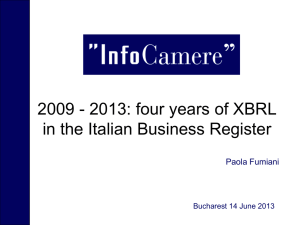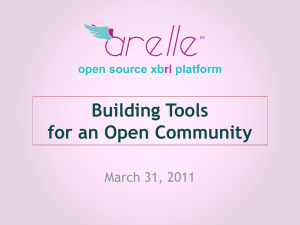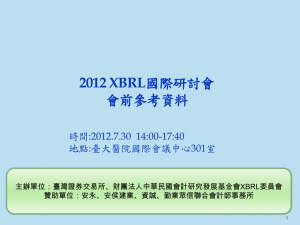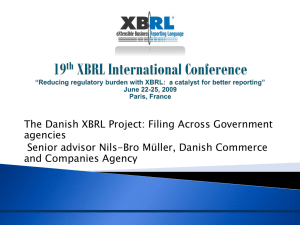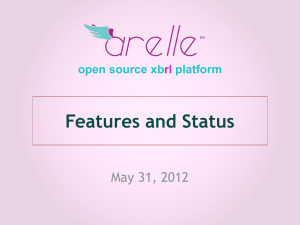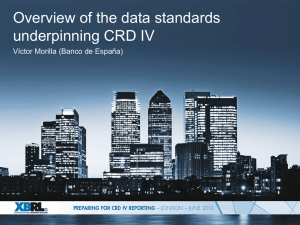here - Federal Spending Transparency
advertisement
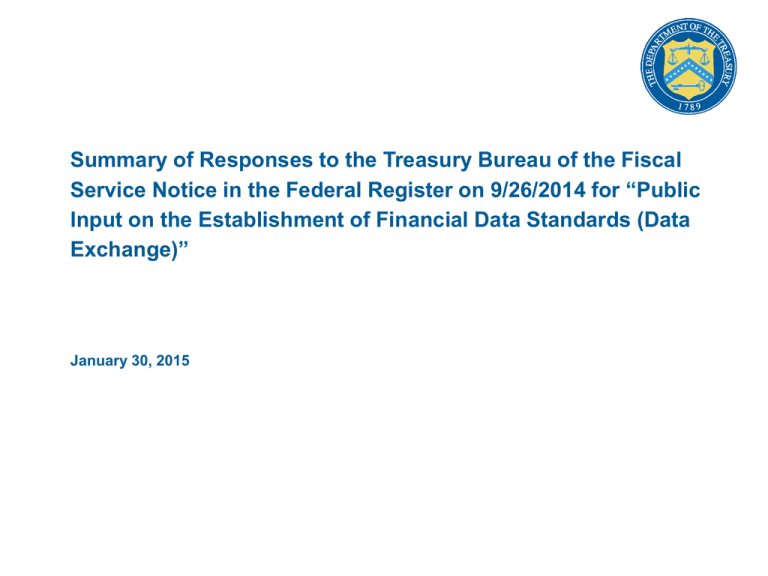
Summary of Responses to the Treasury Bureau of the Fiscal Service Notice in the Federal Register on 9/26/2014 for “Public Input on the Establishment of Financial Data Standards (Data Exchange)” January 30, 2015 |2| Topics Background Overview of responses Summary of responses for each question |3| Background On 9/26/2014, the Treasury Bureau of the Fiscal Service issued a notice in the Federal Register on “Public Input on the Establishment of Financial Data Standards (Data Exchange)” The notice requested comments from private and public stakeholders on several data standard topics and questions “to better ensure the data standards to be established by Treasury and OMB are informed and useful, and to ensure compliance with DATA Act consultation requirements.” Comments were due on November 25, 2014. The notice requested comments on the following: A. Examples of data standards on data exchange that could ensure the data is “open.” B. Examples of data standards on data exchange that could ensure that “availability” goals are met. C. Examples of data standards on data exchange that could ensure the data provides efficient “business reach” to foster private sector innovation. D. Examples of data standards on data exchange that could ensure the implementation of appropriate “validation” processes. E. Examples of data standards on data exchange that could ensure appropriate “extensibility.” F. Examples of data standards on data exchange that could ensure Ease of Implementation. G. How would the data standards benefit or add value to your constituent group or pertinent stakeholders? H. What use cases would you anticipate or envision? I. What impact would data standards have on you, your business, constituent group, or pertinent stakeholders and investments? J. What other criteria should be considered by Treasury and OMB in establishing the data standards on data exchange? |4| Approach Record metadata from all responses – Name of respondent, organization, posted date, unique identifier, etc. Determine number of responses for each question Summarize information provided for each question, without validation or assessment of response content |5| Overview of Responses Fiscal Service received 34 unique responses* – 12 responses answered all the questions FRN Question Number of Responses – 6 responses answered some of questions A 16 – 16 responses did not answer any questions B 14 C 13 D 16 E 16 F 14 G 16 H 16 I 14 J 14 In addition, a number of respondents provided useful recommendations for establishing Financial Data Standards for Data Exchange** that went beyond the scope of the questions * Two of the 35 responses were identical ** Based on the Data Management Association (DAMA) Guide to the Data Management Body of Knowledge (DMBOK) |6| Question A: Open Data Summary of Responses Please describe or provide examples of data standards on data exchange that could ensure the data is “open.” Open in this context means anyone can access, use, or re-use posted information, including the public, Federal agencies, local and state governments, academia, media, industry, standard-setting bodies, transparency groups, on a worldwide scale. Summary of Responses An open standard should be selected and prescribed. Many standards are available: most commonly recommended were XML, XBRL, JSON, NIEM, and extending XML.* Both information technology (IT) systems and humans should be able to read and process the data. Standard should use implementation practices that support open implementation. This includes human readable labels, license free data, and sharing of tools and software that support data standards. * XML: Extensible Markup Language – http://www.w3.org/XML/ XBRL: eXtensible Business Reporting Language) – https://www.xbrl.org/ UBL: Universal Business Language – https://www.oasis-open.org/committees/tc_home.php?wg_abbrev=ubl JSON: JavaScript Object Notation – http://www.json.org/ NIEM: National Information Exchange Model – https://www.niem.gov/Pages/default.aspx Respondents Ambur Publish What You Fund Mark V Systems Limited P3 Data Systems, Inc. OASIS Universal Business Language Technical Committee AICPA CGI Federal, Inc. Hoffman IRIS Business Services Limited PWC Sunlight Foundation Booz Allen Hamilton AGA Data Transparency Coalition XBRL.US Center for Organizational Analysis |7| Question B: Available Data Summary of Responses What are examples of data standards on data exchange that could ensure that “availability” goals are met? Availability in this context means free access to the data standard, both during development, at final stage, and for translations. Availability is assurance that core technologies can be implemented royalty-free. Summary of Responses Several standards are available that are generally free of charge: XML, XBRL, UBL, JSON, and NIEM. Recommended practices to enable creation of an implementation environment that supports free access and availability include: – Engaging software vendors to support implementation – Maximizing explicit common definitions – Implementing community tools and practices – Implementing strong governance Respondents Ambur Mark V Systems Limited P3 Data Systems, Inc. OASIS Universal Business Language Technical Committee AICPA CGI Federal, Inc. Hoffman IRIS Business Services Limited PWC Sunlight Foundation Booz Allen Hamilton Data Transparency Coalition XBRL.US Center for Organizational Excellence |8| Question C: Business Reach Summary of Responses What are examples of data standards on data exchange that could ensure the data provides efficient “business reach” to foster private sector innovation? Business reach refers to the global reach of the business community with either local or global integration opportunities. The end points of business reach are regional (business integration remains a regional area of opportunity) or international (business integration has the potential for direct links to the international community). Summary of Responses Using open standards will enable leveraging the contributions of the business community by increasing its ability to collaborate. Examples include XML, XBRL, UBL, JSON, and NIEM. Use common exchange formats to enable leveraging existing business capabilities: REST* application programming interfaces (APIs) and JSON. Standardize data to the greatest practical extent to enable common exchange and engagement with the business community. * REST: Representational State Transfer: http://www.restapitutorial.com/lessons/whatisrest.html Respondents Ambur Mark V Systems Limited P3 Data Systems, Inc. OASIS Universal Business Language Technical Committee AICPA CGI Federal, Inc. Hoffman IRIS Business Services Limited PWC Booz Allen Hamilton Data Transparency Coalition XBRL.US Center for Organizational Excellence |9| Question D: Validation Summary of Responses Please describe or provide examples of data standards on data exchange that could ensure the implementation of appropriate “validation” processes. Validation means an ongoing process for validation and integration. Validation has spectrum end points that are rules-based or document-based. Rules-based refers to business rules which are interwoven into the standard output and governance body. Document-based end points are business rules separately stored, not entirely contained within the standard output or governance body. Summary of Responses Several data standards have built in features for the rules and document supported validation: XBRL, UBL, WS-Security, Schematron, and RULEML.* Some commercial products also include rules-based validation. Several respondents recommended approaches to enable validation processes: – Address the major types of validation: identity verification, source validation, data format validation, rule-based validation for data consistency, validation across multiple data submissions, and validation across the federal spending life cycle – Seek to strike a balance between easily achievable, rules-based validations and those that might be more difficult to automate or require agency-specific approaches – Establish a governing board, which is an important step to implementing validation processes * Schematron – http://www.schematron.com/ RULEML: Rule Markup Language – http://wiki.ruleml.org/index.php/RuleML_Home Respondents Ambur Publish What You Fund Mark V Systems Limited P3 Data Systems, Inc. OASIS Universal Business Language Technical Committee AICPA CGI Federal, Inc. Hoffman IRIS Business Services Limited PWC Texas Education Agency Booz Allen Hamilton AGA Data Transparency Coalition XBRL.US Center for Organizational Excellence | 10 | Question E: Extensibility Summary of Responses Please describe or provide examples of data standards on data exchange that could ensure appropriate “extensibility.” “Extensibility” in this context is defined as functionality for flexibility (maintenance) of future modification to the data standard. The end points of the spectrum for these criteria are flexible and rigid. Flexible references extensibility and implementation ease, whereas rigid relates to the pliability of the construction and rules integration. Summary of Responses XBRL is extensible and flexible. The capability to add elements to the taxonomy can provide unique definitions and labels so that the information can be transparent to anyone consuming the data. – Allows for the continuing growth and change necessitated by changes in reporting requirements – Allows individual reporting entities to report information that is unique to their organizations and that has not been included in the standard set of concepts/terms available to use in the standard UBL is extensible in that it enables the validation of user-defined additions to the standard schemas. Respondents Ambur Publish What you Fund Mark V Systems Limited P3 Data Systems, Inc. OASIS Universal Business Language Technical Committee AICPA CGI Federal, Inc. Hoffman IRIS Business Services Limited PWC Texas Education Agency Booz Allen Hamilton AGA Data Transparency Coalition XBRL.US Center for Organizational Excellence | 11 | Question F: Ease of Implementation Summary of Responses Please describe or provide examples of data standards on data exchange that could ensure Ease of Implementation. Ease of Implementation refers to integration and interoperability within a given environment. The related end points are simple (easily integrates into environment) or difficult (integration into environment necessitates extra steps). Summary of Responses XBRL is an example of a data standard that supports ease of implementation. – Respondent recommends adoption of a specific profile of XBRL that limits the complexity (tuples, excess dimensions) while retaining the powerful metadata in consistent format. – Implementing XBRL for the reporting of business information requires the development of a taxonomy to be used for the reporting application. – The XBRL standard has been adopted across a wide range of domains, including stock exchanges, central banks, business registries, securities commissions, tax authorities, and other federal and local government agencies. UBL is another example of a data standard that supports ease of implementation. – UBL is designed to plug directly into existing business, legal, auditing, and records management practices, eliminating the re-keying of data in existing fax- and paper-based supply chains. Other examples of data standards on data exchange include REST/JSON, CSV, and TXT. – Respondent believes these standards are much more developer friendly and are increasingly becoming the preferred mechanisms for information sharing in IT environments. – Respondent considers JSON a great standard for mobile devices, which are the common medium of information processing by citizens and other public organizations. – Respondent considers that CSV and/or TXT may be better for data statistical analysis processes. Respondent recommends building on standards currently being used by Treasury. Respondents Ambur Mark V Systems Limited P3 Data Systems, Inc. OASIS Universal Business Language Technical Committee AICPA CGI Federal, Inc. Hoffman IRIS Business Services Limited PWC Booz Allen Hamilton AGA Data Transparency Coalition XBRL.US Center for Organizational Excellence | 12 | Question G: Benefits Summary of Responses How would the data standards examples or descriptions on data exchange you provided in A-F above, if implemented, benefit or add value to your constituent group or pertinent stakeholders? Summary of Responses Increases consistency in data that is fully interoperable Improves the public’s ability to access and share Federal spending data Reduces the amount of errors that can occur in manual processes Reduces burden of reporting on recipients receiving federal funds Reduces nonconformance to complex financial reporting rules Optimizes development for a single standardized implementation by decreasing the number of APIs, which increases the overall productivity of the software development process Easier to analyze the accuracy and completeness of the data, ensuring its reliability Better data to support their own benchmarking and competitive analysis States with central grant office functions or state comptrollers would be able to easily view and download data from USASpending.gov for all state data Enhanced data analytics Enhanced data presentation to myriad stakeholder groups, including policy makers, subject matter experts, taxpayers, and citizens Private industry (large and small businesses) and not-for-profit organizations would be better able to mine and analyze data and identify business opportunities and focus areas Achieve better accountability, better management, and automatic compliance in federal spending reports. Providing trustworthy data to watchdogs both inside and outside the government. Respondents Ambur Mark V Systems Limited P3 Data Systems, Inc. OASIS Universal Business Language Technical Committee AICPA CGI Federal, Inc. Hoffman IRIS Business Services Limited PWC Texas Education Agency Sunlight Foundation Booz Allen Hamilton AGA Data Transparency Coalition XBRL.US Center for Organizational Excellence | 13 | Question H: Use Cases Summary of Responses What use cases would you anticipate or envision for information with data structured in accordance with established data standards on data exchange? Summary of Responses Implementing a solution that creates an environment of consolidated data that is available to the government and private sector communities (i.e., a data centric environment). Enabling greater analytics and better decision making through greater data consolation/association, access, and quality. – Examples of Consolidation/Association: enabling the comparison of data from a contractor supporting multiple contracts; and accessing enterprise view of federal spending across agencies and programs – Example of Access: viewing data from multiple sources at the same time – Example of Quality: comparing data with other sources of Federal spending information to determine data quality Improve the private sectors’ accountability, management, and compliance in federal spending reports. Enable improved views or reports of financial data (for example: full lifecycle, geospatial, information hierarchies; and conducting oversight on specific contracts). Respondents REI Systems Ambur Mark V Systems Limited P3 Data Systems, Inc. OASIS Universal Business Language Technical Committee AICPA CGI Federal, Inc. Hoffman IRIS Business Services Limited PWC Sunlight Foundation Booz Allen Hamilton AGA Data Transparency Coalition XBRL.US Center for Organizational Excellence | 14 | Question I: Impact Summary of Responses What impact would established and implemented data standards on data exchange have on you, your business, constituent group or pertinent stakeholders, and investments? Summary of Responses Provide greater clarity into Government goals and the effectiveness of grant programs, resulting in better allocation of resources and more effective results. Implementation of standards will cause increased costs for some private and government entities due to changes in their processes or technology from legacy implementations. Greater access to data and standardization will enable private sector entities to focus their resources on better solutions or priorities for the government. Audit reporting and related processes may be more effective with standardized data and a standardized rules processing environment. Respondents Ambur Mark V Systems Limited P3 Data Systems, Inc. OASIS Universal Business Language Technical Committee AICPA CGI Federal, Inc. Hoffman IRIS Business Services Limited PWC Texas Education Agency Booz Allen Hamilton Data Transparency Coalition XBRL.US Center for Organizational Excellence | 15 | Question J: Other Criteria Summary of Responses What other criteria should be considered by Treasury and OMB in establishing the data standards on data exchange? Summary of Responses Supporting functions/capabilities will be critical to the effectiveness of establishing data standards: – – – – – Stewardship of the data Security Data management/data governance Metadata Outreach and change management Ensure that the developed data standards remain flexible (for example, integrating with other standards and ability to account for related kinds of reporting that are not strictly financial). Planning for implementation should take into account potentially significant and complex changes required by supporting systems and organizations. Leverage best practices for data standardization and for implementing systems that will use the data: – – – Consolidate data elements based on requirements of other reporting needs where possible (i.e., Standard Business Reporting). Leverage incremental and iterative development for new or modernized systems. Semantic linkages are crucial to connecting financial data to other sources of data. A robust review and validation process for data standards is important, and as part of the process, some amount of manual effort to evaluate the quality of the data will be necessary. Respondents Ambur REI Systems P3 Data Systems, Inc. OASIS Universal Business Language Technical Committee AICPA CGI Federal, Inc. Hoffman IRIS Business Services Limited PWC Booz Allen Hamilton AGA Data Transparency Coalition XBRL.US Center for Organizational Excellence


